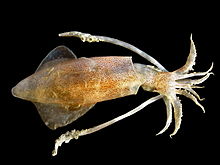
Back Мантия (орган) Bulgarian Mantell (anatomia) Catalan Plášť (zoologie) Czech Mantel (Weichtiere) German Μανδύας (μαλακίων) Greek Manto (moluscos) Spanish Manteau (mollusque) French Maintlín (moileasc) Irish Manto (moluscos) Galician Köpeny (anatómia) Hungarian



The mantle (also known by the Latin word pallium meaning mantle, robe or cloak, adjective pallial) is a significant part of the anatomy of molluscs: it is the dorsal body wall which covers the visceral mass and usually protrudes in the form of flaps well beyond the visceral mass itself.
In many species of molluscs the epidermis of the mantle secretes calcium carbonate and conchiolin, and creates a shell. In sea slugs there is a progressive loss of the shell and the mantle becomes the dorsal surface of the animal.
The words mantle and pallium both originally meant ‘cloak’ or ‘cape’; see mantle (vesture). This anatomical structure in molluscs often resembles a cloak because in many groups the edges of the mantle, usually referred to as the mantle margin, extend far beyond the main part of the body, forming flaps, double-layered structures which have been adapted for many different uses, including for example, the siphon.
© MMXXIII Rich X Search. We shall prevail. All rights reserved. Rich X Search